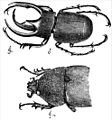
The family Scarabaeidae, as currently defined, consists of over 35,000 species of beetles worldwide; they are often called scarabs or scarab beetles. The classification of this family has undergone significant change in recent years. Several groups formerly treated as subfamilies have been elevated to family rank, and some reduced to lower ranks. The subfamilies listed in this article are in accordance with those in Catalog of Life (2023).
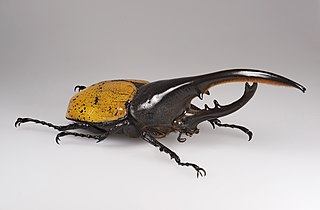
The Hercules beetle is a species of rhinoceros beetle native to the rainforests of southern Mexico, Central America, South America, and the Lesser Antilles. It is the longest extant species of beetle in the world, and is also one of the largest flying insects in the world.

Dynastinae or rhinoceros beetles are a subfamily of the scarab beetle family (Scarabaeidae). Other common names – some for particular groups of rhinoceros beetles – include Hercules beetles, unicorn beetles or horn beetles. Over 1,500 species and 225 genera of rhinoceros beetles are known.

Allomyrina dichotoma, also known as the Japanese rhinoceros beetle or Japanese horned beetle, is a species of rhinoceros beetle. They are commonly found in continental Asia in countries such as China, the Korean peninsula, Japan, and Taiwan. In these areas, this species of beetle is often found in broad-leaved forests with tropical or sub-tropical climates. This beetle is well known for the prominent cephalic horn found on males. Male Japanese rhinoceros beetles will use this horn to fight other males for territory and access to female mating partners. Upon contact, males will attempt to flip each other onto their backs or off of their feeding tree. In response to selective pressures, smaller male A. dichotoma have adapted a "sneak-like behavior". These smaller beetles will attempt to avoid physical confrontation with larger males and try to mate with females.
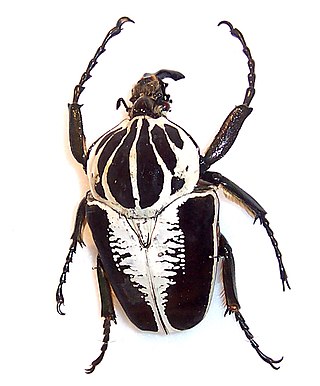
The Goliath beetles are any of the five species in the genus Goliathus. Goliath beetles are among the largest insects on Earth, if measured in terms of size, bulk and weight. They are members of subfamily Cetoniinae, within the family Scarabaeidae. Goliath beetles can be found in many of Africa's tropical forests, where they feed primarily on tree sap and fruit. Little appears to be known of the larval cycle in the wild, but in captivity, Goliathus beetles have been successfully reared from egg to adult using protein-rich foods such as commercial cat and dog food. Goliath beetles measure from 60–110 millimetres (2.4–4.3 in) for males and 50–80 millimetres (2.0–3.1 in) for females, as adults, and can reach weights of up to 80–100 grams (2.8–3.5 oz) in the larval stage, though the adults are only about half this weight. The females range from a dark chestnut brown to silky white, but the males are normally brown/white/black or black/white.

Goliathus orientalis is a species of beetles belonging to the family Scarabaeidae.
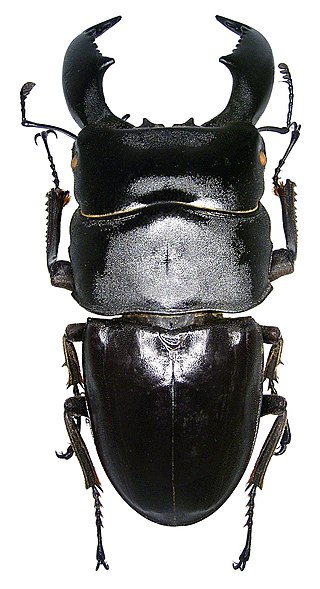
Dorcus titanus is a beetle of the family Lucanidae. It was described by Jean Baptiste Boisduval in 1835. Huang and Chen (2013) separated Serognathus from Dorcus by representing morphological characters and DNA analysis.

Xylotrupes gideon, the brown rhinoceros beetle, is a species of large scarab beetle belonging to the subfamily Dynastinae.

Dynastes satanas, the Satanas beetle, is a species of beetle belonging to the family Scarabaeidae. The name is sometimes misspelled as "satanus".

Cyclommatus metallifer is a species of stag beetle in the family Lucanidae. There is sexual dimorphism within the species. Males are generally larger in size and have enlarged mandibles. It is named for its metallic coloration, which ranges in color and may be varying levels of black, brown, or gold. This species is notably easy to maintain, making it a useful species for scientific study. Additionally, it has been kept as an exotic pet.

Hexarthrius parryi, the fighting giant stag beetle, is a species of large stag beetles. It belongs to the genus Hexarthrius of the tribe Lucanini. It is classified under the subfamily Lucaninae of the stag beetle family Lucanidae.

Scelophysa trimeni, commonly known as the blue monkey beetle, is a species of scarab beetles in the tribe Hopliini, subfamily Melolonthinae.
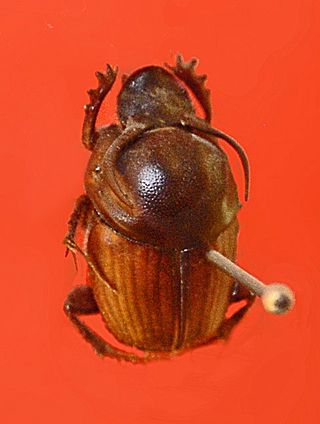
Onthophagus taurus, the taurus scarab, is a species of dung beetle in the genus Onthophagus and the family Scarabaeidae. Also known as the bull-headed dung beetle, it is a species that specializes in cattle dung and is widely utilized to maintain clean pastures, making it agriculturally valuable. These beetles are typically 8–10 millimetres (0.31–0.39 in) in size. The males of this species exhibit distinct characteristics: large “major” males possess long, sweeping, curved horns resembling those of a longhorn bull, while small “minor” males have tiny horns that project upward from the back of their heads. Females, on the other hand, lack horns. These small beetles are oval shaped, the color is usually black or reddish brown. Sometimes the pronotum has a weak metallic sheen.

The Moellenkampi beetle, is one of four large species of rhinoceros beetles from Southeast Asia belonging to the genus Chalcosoma. The Moellenkampi beetles belong to the beetle family Scarabaeidae along with other rhinoceros beetles. They are characterized by having two large, forward-projecting horns on the pronotum or thorax, and another large, forward and upward-projecting horn on the head. They also have a distinct metallic lustre, which is the reason behind their genus name, which derives from Greek, chalko-, and is the combining form of chalkós, meaning copper.
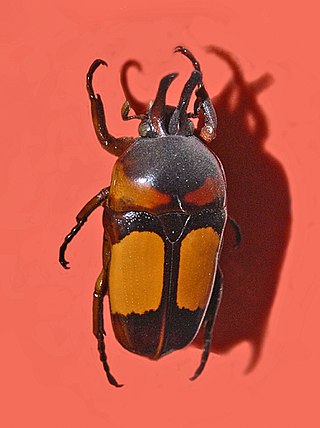
Dicheros bicornis is a species of beetles belonging to the family Scarabaeidae, subfamily Cetoniinae.
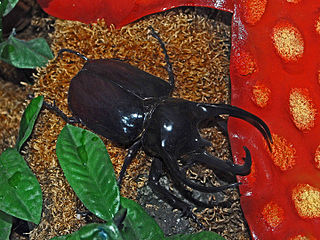
Chalcosoma chiron is a species of beetle in the family Scarabaeidae. This species can be found from Malaysia south into Indonesia and Thailand in East region. It was formerly known as Chalcosoma caucasus, a name which is a junior synonym and not valid.
Chalcosoma engganensis is a large (35–60 mm) and heavy beetle. The body is shiny black. The male has a sharp horn on the head. On each side of pronotum there are curved, forward directed horns. Across the head there is a short but powerful spike. This species differs from the normally developed specimens of the other Chalcosoma species in that horns are shorter, male can look a lot like small copies of Chalcosoma moellenkampi. The female lacks these horns and spikes, and is smaller.

Coprophanaeus ensifer is a large South American species of beetle belonging to the family Scarabaeidae. This species is necrophagous and builds burrows near or on animal carcasses to dismember the flesh of decaying bodies and bring it to its burrow to feed. Both females and males help build the burrow and feed. It is characterized by its iridescent colors and a horn that is similar in shape and size in females and males. It uses its horn to tear apart carcasses and to fight with other individuals, with male-male fighting occurring more often. However, females also fight to determine a variety of characteristics of the opposing male. This species may be of importance in forensic science due to its destructive behavior on decaying bodies, especially in areas of Brazil where homicide rates are high.

Megasoma anubis is a species of beetles belonging to the family Scarabaeidae.
Eudicella frontalis is a beetle which belongs to the group of flower chafers in the superfamily Scarabaeoidea.

